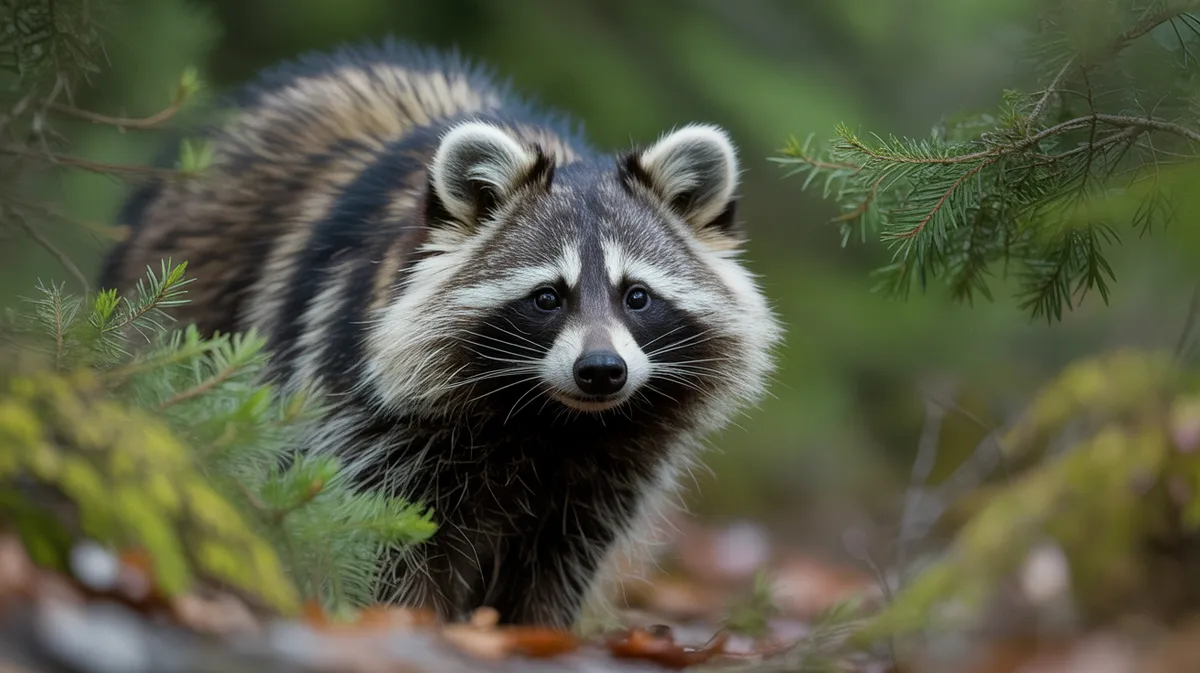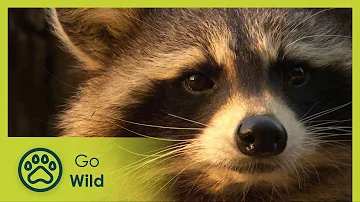
Raccoon Dog
Nyctereutes procyonoides

Meet the Raccoon Dog
The raccoon dog is a unique canid native to East Asia, easily recognized by its dense fur, bushy tail, and facial markings that resemble those of a raccoon. Unlike true raccoons, it belongs to the dog family (Canidae) and is the only extant species in its genus, Nyctereutes. Raccoon dogs are highly adaptable, inhabiting forests, wetlands, and even urban areas. They are known for their omnivorous diet and unusual behaviors, such as hibernating during cold winters—a rarity among canids.
Classification
Mammal
Habitat
Temperate forests
Diet
Omnivore
Lifespan
6-11 years
Conservation
Least Concern
Weight
4.5–10 kg
📖Fascinating Facts
Unique Canid
Raccoon dogs are the only canids known to hibernate during winter, a trait uncommon among their relatives.
Family Ties
They form lifelong monogamous pairs, with both parents sharing in the care of their pups.
Adaptable Habitats
Raccoon dogs thrive in a variety of habitats, from dense forests and wetlands to farmlands and urban outskirts.
📋Detailed Description
The raccoon dog (Nyctereutes procyonoides) is a medium-sized canid, typically weighing between 4 and 10 kg, with a body length of 50–68 cm and a tail length of 13–25 cm. Its dense, coarse fur is especially thick in winter, providing insulation against cold climates, and features distinctive black facial markings resembling those of raccoons, despite no close relation. The body is stocky with short legs, and the head is broad with rounded ears. Unlike most canids, raccoon dogs possess partially webbed toes, aiding in swimming and movement through wetlands. They are primarily nocturnal and crepuscular, exhibiting secretive behavior and utilizing dense vegetation for cover. Socially, raccoon dogs are monogamous, forming long-term pair bonds and often sharing territories with their mate. They are opportunistic omnivores, consuming a varied diet that includes small mammals, amphibians, birds, insects, fruits, and carrion. Unique among canids, raccoon dogs undergo winter torpor (a form of hibernation), reducing metabolic activity and relying on fat reserves. Their vocalizations include growls, whines, and barks, used for communication within pairs or family groups. Raccoon dogs are highly adaptable, thriving in diverse habitats ranging from forests and wetlands to agricultural and urban landscapes.
💡 Did you know?
Despite their name and appearance, raccoon dogs are not closely related to raccoons; they are members of the dog family and represent a distinct evolutionary branch.
🔬Research & Sources
Wikipedia Summary
Nyctereutes is a genus of canid which includes only two extant species, both known as raccoon dogs: the common raccoon dog and the Japanese raccoon dog. Nyctereutes first entered the fossil record 5.5 million years ago (Mya) in northern China. It was one of the earliest canines to arrive in the Old World. All but two species became extinct before the end of the Pleistocene. A study suggests that the evolution of Nyctereutes was influenced by environmental and climatic changes, such as the expansion and contraction of forests and the fluctuations of temperature and precipitation.
Last Modified: 6/3/2025
🎭Behavior & Social Structure
Raccoon dogs are primarily nocturnal, emerging at dusk to forage and returning to dens before dawn. They exhibit solitary or pair-based foraging, rarely forming larger groups except during the breeding season or when rearing young. Their omnivorous diet shifts seasonally: in spring and summer, they consume more animal prey such as rodents, amphibians, and insects, while in autumn and winter, they rely heavily on fruits, berries, and carrion. Raccoon dogs are known for their meticulous food caching behavior, storing surplus food in concealed locations. They are skilled swimmers and climbers, often using water bodies to escape predators or search for food. Home ranges vary from 1 to 10 km², depending on habitat quality and food availability. Communication within pairs involves scent marking, vocalizations, and body postures. During the winter, raccoon dogs reduce activity significantly, entering a state of torpor in burrows or natural cavities, often with their mate.
👶Reproduction & Life Cycle
Raccoon dogs are monogamous, with pairs forming stable bonds that often persist across multiple breeding seasons. The breeding season typically occurs from February to April, varying with latitude. After a gestation period of 59–64 days, females give birth to litters averaging 6–8 pups, though litters of up to 15 have been recorded. Both parents participate in rearing the young, with males providing food and protection while females nurse. Pups are born blind and helpless, opening their eyes at around 9–10 days and weaning at 30–40 days. Family groups remain together until autumn, when juveniles disperse to establish their own territories. High reproductive potential allows raccoon dogs to rapidly colonize new areas, contributing to their success as an invasive species in parts of Europe.
🛡️Adaptations & Survival
Raccoon dogs have evolved several unique adaptations among canids. Their dense, water-resistant fur provides insulation and protection in cold, wet environments. The ability to accumulate substantial fat reserves in autumn enables them to survive prolonged periods of winter torpor, a rare trait in the dog family. Their omnivorous dentition, featuring broad molars and robust jaws, allows efficient processing of both animal and plant matter. Partially webbed feet facilitate swimming, while their cryptic coloration and secretive habits reduce predation risk. Behavioral flexibility, including food caching and habitat generalism, enhances survival in variable environments. These adaptations have enabled raccoon dogs to thrive across a wide geographic range, from temperate forests to urban edges.
📚Research Sources
🎨Cultural Significance
In East Asian cultures, particularly in Japan, the raccoon dog (tanuki) holds significant mythological and folkloric importance. Tanuki are depicted as shape-shifters and symbols of prosperity, mischief, and good fortune in Japanese folklore, frequently appearing in art, literature, and popular culture. In China and Russia, raccoon dogs have been traditionally hunted for their fur, which is commercially valuable. Their adaptability has led to their presence in urban legends and rural traditions, sometimes viewed as omens or trickster figures. In Europe, their introduction has sparked ecological and cultural debates regarding invasive species management.
🔬Recent Research & Discoveries
Recent genetic studies have clarified the taxonomy of Nyctereutes, distinguishing the Japanese raccoon dog (N. viverrinus) as a separate species from the mainland form (N. procyonoides). Ongoing research focuses on their role as disease reservoirs, particularly for rabies and Echinococcus multilocularis, with implications for public health. Ecological studies in Europe monitor their impact on native wildlife, especially ground-nesting birds and amphibians. Climate change research examines how shifting temperatures affect torpor duration and reproductive timing. Fossil evidence indicates that Nyctereutes was among the earliest canids to colonize the Old World, with evolutionary adaptations linked to Pleistocene environmental fluctuations.
🎥Wildlife Videos

Wild Dogs Everywhere: Wolves, Foxes and Coyotes
Run with packs of free spirits … the planet's Wild Dogs. This full wildlife documentary is a celebration of Canines, from howling ...
Get.factual

Meet the Raccoon Dogs of South Korea | Wild Korea
About National Geographic Wild: National Geographic Wild is a place for all things animals and for animal-lovers alike. Take a ...
Nat Geo Animals

The Raccoon Dog
This is a video of the raccoon dog taken from the BBC's Life of Mammals.
globalzoo

The hidden world of raccoons | Go Wild
Today approximately half a million raccoons are living in Germany. It all started in the first half of the last century with fur farms.
Go Wild

National Geographic Animals - How Smart Are Raccoons. Oct 2016
National Geographic Animals - How Smart Are Raccoons. Oct 2016.
thuy nhu

Tanuki: The Dog That Thinks It’s A Raccoon
This is the only Canid that hibernates. It also looks like a raccoon. This is the Raccoon Dog. Special thanks to Japan Trail Cam, ...
Animalogic
🌍Habitat Information
The Raccoon Dog typically inhabits Temperate forests environments. Raccoon Dogs have adapted to their environments with specialized features and behaviors.
Primary Habitat:
Temperate forests
More detailed habitat information will be available soon.
🛡️Conservation Status
The Raccoon Dog is currently classified as Least Concern. Conservation efforts are crucial for preserving this species for future generations.
Common Threats:
- 🏠Habitat loss and fragmentation
- 🌡️Climate change impacts
- 🎯Hunting and poaching
- 🏭Human-wildlife conflict
⚠️Threats & Conservation Challenges
While globally listed as Least Concern by the IUCN, raccoon dogs face localized threats such as habitat loss, road mortality, hunting for fur, and disease transmission (notably rabies and canine distemper). In their native range, populations are stable, but in introduced areas (notably Eastern and Northern Europe), they are considered invasive, impacting native fauna through predation and competition. Human expansion and agricultural development can fragment habitats, though raccoon dogs often adapt to anthropogenic landscapes. Fur trapping remains a significant threat in parts of Russia and China. Disease outbreaks periodically reduce populations, and climate change may alter hibernation patterns and food availability.
🔬Scientific Classification
Scientific Name
Nyctereutes procyonoides
Classification Hierarchy
🔍 About Taxonomic Classification
Taxonomic classification is a hierarchical system used by scientists to classify and organize living organisms based on shared characteristics and evolutionary relationships.
The system moves from broad categories (Kingdom) to increasingly specific ones, with each animal's scientific name typically consisting of its Genus and species.
📝Community Notes
Share your observations and insights about the Raccoon Dog with our community of wildlife enthusiasts.
Join Our Community
Sign in to share your observations and connect with fellow wildlife enthusiasts.
Sign In to ContributeNo community notes yet
Be the first to share your observations about the Raccoon Dog!
Explore Raccoon Dog
Select a tab above to learn more about this amazing animal.
📸Photo Gallery
No photos available for this animal yet.
🌟Discover More Wildlife
Continue your journey of discovery with more fascinating animals from our database
